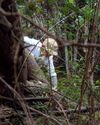
If you've ever stepped into a freshly-carpeted room, you will know the distinct odour that comes with it. Kind of fresh, kind of chemically, it's a smell that announces that the decorators have done their jobs, and suggests that anybody entering the room will be asked to leave their shoes in the doorway. It's a dying smell, though. At trade fairs and showrooms across the world, that 'new carpet' smell is disappearing as the carpeting industry finds new, healthier ways to manufacture its products.
The problem with that 'new carpet' smell is that it's produced by the off-gassing of VOCs, like 4-PCH, which is commonly used in carpeting. VOCs are known to cause rashes, eye irritation and respiratory problems.
According to the US non-profit Environmental Working Group (EWG), most carpeting around the world is made from synthetic fibres derived from non-renewable petroleum-based sources, while carpet backing is usually made from synthetic rubber derived from respiratory irritants such as styrene and butadiene. The harmful fumes from those synthetic rubbers, fibres, adhesives, bonding agents and stain-resistant finishers are what you are really breathing in every time you sigh with satisfaction at the soft feeling under your feet.
Those chemicals and compounds are also what makes carpeting difficult to recycle. Unable to separate the fibres from the underlay or the various VOCs from each other, many recycling collector/ sorter entrepreneurs do not bother with the discarded carpets that come their way. 'Most people don't understand but carpet is a highly engineered material; Bruce Petrovick, account manager for the Dutch manufacturing company DSM told Fast Company. 'The way it's traditionally made, it contains multiple layers, and each layer contains multiple different types of materials.
Diese Geschichte stammt aus der Garden&Home; July 2023-Ausgabe von South African Garden and Home.
Starten Sie Ihre 7-tägige kostenlose Testversion von Magzter GOLD, um auf Tausende kuratierte Premium-Storys sowie über 8.000 Zeitschriften und Zeitungen zuzugreifen.
Bereits Abonnent ? Anmelden
Diese Geschichte stammt aus der Garden&Home; July 2023-Ausgabe von South African Garden and Home.
Starten Sie Ihre 7-tägige kostenlose Testversion von Magzter GOLD, um auf Tausende kuratierte Premium-Storys sowie über 8.000 Zeitschriften und Zeitungen zuzugreifen.
Bereits Abonnent? Anmelden

Winter Warmer
Properly insulated homes are the next frontier for South Africa in a world of higher energy costs and a harsher climate

Carved in MARBLE
Use marble around your home to create an instantly luxurious feel

A Lesson From The Animal Kingdom
Not all of us are graceful ballet dancers or stylish fashion followers, but we can still stake a claim to elegance

Nature's Hidden Harvest
Clutching a bovine bolete deep inside a pine forest, Ryan Enslin discovers nature's bounty as he unearths her hidden gems and edible treasures

PAPER BRIQUETTES
Fuel your winter fire with these home-made briquettes made from recycled paper that you would otherwise throw away. Each brick burns for up to 1.5 hours

WINTER DOS AND DON'TS HOUSEPLANTS
Winter houseplant care is not complicated, but there are a few essential tips to follow to keep your plants alive until spring arrives

In The Garden
July Garden To-dos

ELEGANT AGAVES
Low-maintenance and always looking their best, you can't ask for much more from these showstoppers

MIRROR UPDATE
Turn any old or plain rectangular mirror into luxe home decor with this simple and beginner-friendly DIY

LOFT LUXE
This Cape Town loft remodel, inspired by Balinese living, shows how much of an impact minimalist design can make in small spaces